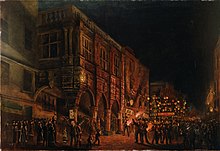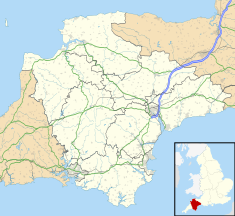Exeter Guildhall
| Exeter Guildhall | |
|---|---|
 | |
| Location | Exeter, Devon, England |
| Coordinates | 50°43′24″N 3°31′54″W / 50.7233°N 3.5318°W |
| Built | 1470 |
| Architectural style(s) | Ornate Italian style |
Listed Building – Grade I | |
| Designated | 29 January 1953 |
| Reference no. | 1103905 |
Exeter Guildhall on the High Street of Exeter, Devon, England has been the centre of civic government for the city for at least 600 years. Much of the fabric of the building is medieval, though the elaborate frontage was added in the 1590s and the interior was extensively restored in the 19th century. It is a Grade I listed building.[1]
History

Early history
It is certain that the hall has been on its present site since the 14th century,
The current building was constructed between 1468 and 1470.
The city stocks were once under the portico. The elaborately carved oak door, dated 1593, was made by Nicholas Baggett, a local carpenter.[2] It leads via an anteroom to the council chamber which apparently dates between 1468 and 1470,[8] though it was much restored in Victorian times. The oak panelling around the main hall probably dates from 1594 when the portico was added.[6] The arch-braced roof with seven bays is original; its main trusses rest on carved corbels representing grotesque animals.[2][9]
It was in Exeter Guildhall that, in the aftermath of the Monmouth Rebellion, Judge Jeffreys held the Bloody Assizes on 14 September 1685.[6][10]
A large chandelier hangs from the centre of the roof. It was made by Thomas Pyke of Bridgwater and installed in 1789. Apart from this and the roof, all the internal fittings are Victorian, including the stained glass, the gallery, the furniture and the stone floor (all 1863) and the heavily restored Tudor panelling (1887). Above the fireplace is a bust of Queen Victoria by Henry Hugh Armstead.[2]

Under the council chamber there is an early 14th-century cellar. This was once a prison that was known as the "pytt of the Guyldhall". In the 16th century another prison, for women, was built on the ground floor at the back of the building. It remained in use until 1887. In 1858 a room was built above this to store the city's records; it was later used as a jury room.[2]

20th century
The front room above the portico, which was once the council chamber, was converted into the mayor's parlour in 1903.
For much of the 20th century the guildhall was the meeting place of the
The former Jury Room was restored, after damage from a collapsed ceiling, in 2023.[14]
The guildhall is still used for civil purposes such as official receptions, mayoral banquets, some City Council meetings, other meetings and exhibitions and occasionally as a magistrates' court.[15]
Heraldry
The main chamber displays on the wooden panelling many heraldic escutcheons displaying the arms of various persons who held high office within the City Corporation, covering much of the heraldry of Devonshire. The heraldry was identified in the View of Devonshire by Thomas Westcote (d. circa 1637)[16] and later expanded upon by Colby, Rev. Frederick T., in his The Heraldry of Exeter.[17]
See also
References
- ^ a b c Historic England. "Guildhall, Exeter (1103905)". National Heritage List for England. Retrieved 25 August 2019.
- ^ ISBN 0-85033-693-7.
- ^ Blaylock 1990, p.123.
- ^ Hoskins 2004, p.24.
- ^ See for example: Hele's School Historical Society. (1947). Exeter—Then and Now. A. Wheaton & Co. p. 31.
- ^ a b c "The Guildhall – High Street". Exeter Memories. Retrieved 6 December 2020.
- ^ Hoskins 2004, p.70.
- ^ ISBN 0-14-071050-7.
- ^ "The Hall - Structure". Exeter City Council. Archived from the original on 27 September 2011. Retrieved 10 December 2010.
- ^ "Monmouth Rebels 1685". Retrieved 6 December 2020.
- ^ Blaylock 1990, pp.128, 146.
- ^ "Exeter Election Petition". Retrieved 25 August 2019.
- ISBN 0-10-547072-4.
- ^ Clark, Daniel. "Exeter's historic Jury Room restored after ceiling collapse". Devon Live. Retrieved 4 August 2023.
- ^ "Introduction". Exeter City Council. Archived from the original on 27 September 2011. Retrieved 10 December 2010.
- ^ View of Devonshire, Chap. XV
- .
Sources
- Blaylock, S. R. (1990), "Exeter Guildhall", Devon Archaeological Society Proceedings, 48: 123–178, ISSN 0305-5795
- ISBN 1-86077-303-6.
Further reading
![]() Media related to Exeter Guildhall at Wikimedia Commons
Media related to Exeter Guildhall at Wikimedia Commons
- Cornforth, David. "History of the Guildhall". Exeter Memories. Archived from the original on 21 November 2010. Retrieved 10 December 2010.

